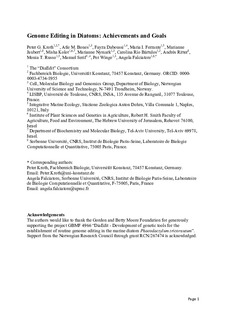| dc.contributor.author | Kroth, Peter G. | |
| dc.contributor.author | Bones, Atle M. | |
| dc.contributor.author | Daboussi, Fayza | |
| dc.contributor.author | Ferrante, Maria I. | |
| dc.contributor.author | Jaubert, Marianne | |
| dc.contributor.author | Kolot, Misha | |
| dc.contributor.author | Nymark, Marianne | |
| dc.contributor.author | Rio Bártulos, Carolina | |
| dc.contributor.author | Ritter, Andrés | |
| dc.contributor.author | Russo, Monia T. | |
| dc.contributor.author | Serif, Manuel | |
| dc.contributor.author | Winge, Per | |
| dc.contributor.author | Falciatore, Angela | |
| dc.date.accessioned | 2019-03-20T14:10:47Z | |
| dc.date.available | 2019-03-20T14:10:47Z | |
| dc.date.created | 2018-08-21T11:04:10Z | |
| dc.date.issued | 2018 | |
| dc.identifier.citation | Plant Cell Reports. 2018, 37 (10), 1401-1408. | nb_NO |
| dc.identifier.issn | 0721-7714 | |
| dc.identifier.uri | http://hdl.handle.net/11250/2590892 | |
| dc.description.abstract | Diatoms are major components of phytoplankton and play a key role in the ecology of aquatic ecosystems. These algae are of great scientific importance for a wide variety of research areas, ranging from marine ecology and oceanography to biotechnology. During the last 20 years, the availability of genomic information on selected diatom species and a substantial progress in genetic manipulation, strongly contributed to establishing diatoms as molecular model organisms for marine biology research. Recently, tailored TALEN endonucleases and the CRISPR/Cas9 system were utilized in diatoms, allowing targeted genetic modifications and the generation of knockout strains. These approaches are extremely valuable for diatom research because breeding, forward genetic screens by random insertion, and chemical mutagenesis are not applicable to the available model species Phaeodactylum tricornutum and Thalassiosira pseudonana, which do not cross sexually in the lab. Here, we provide an overview of the genetic toolbox that is currently available for performing stable genetic modifications in diatoms. We also discuss novel challenges that need to be addressed to fully exploit the potential of these technologies for the characterization of diatom biology and for metabolic engineering. | nb_NO |
| dc.language.iso | eng | nb_NO |
| dc.publisher | Springer | nb_NO |
| dc.relation.uri | https://link.springer.com/article/10.1007/s00299-018-2334-1 | |
| dc.title | Genome editing in diatoms: achievements and goals | nb_NO |
| dc.type | Journal article | nb_NO |
| dc.type | Peer reviewed | nb_NO |
| dc.description.version | acceptedVersion | nb_NO |
| dc.source.pagenumber | 1401-1408 | nb_NO |
| dc.source.volume | 37 | nb_NO |
| dc.source.journal | Plant Cell Reports | nb_NO |
| dc.source.issue | 10 | nb_NO |
| dc.identifier.doi | 10.1007/s00299-018-2334-1 | |
| dc.identifier.cristin | 1603446 | |
| dc.relation.project | Norges forskningsråd: 267474 | nb_NO |
| dc.description.localcode | © Springer-Verlag GmbH Germany, part of Springer Nature 2018. This is a post-peer-review, pre-copyedit version of an article published in Plant Cell Reports. The final authenticated version is available online at: http://dx.doi.org/10.1007/s00299-018-2334-1. Locked until 23.08.2019 due to the copyright restrictions. | nb_NO |
| cristin.unitcode | 194,66,10,0 | |
| cristin.unitname | Institutt for biologi | |
| cristin.ispublished | true | |
| cristin.fulltext | postprint | |
| cristin.qualitycode | 1 | |
